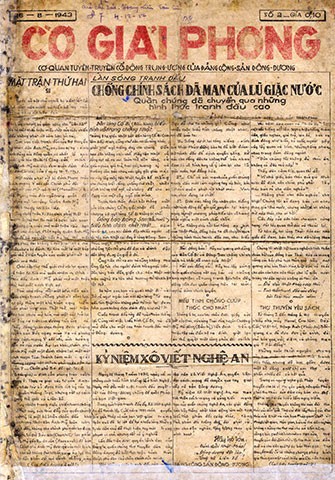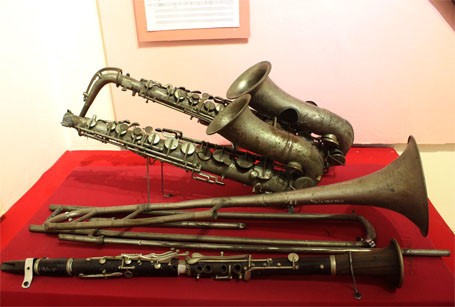(VOVworld) – As the Vietnamese people celebrate the National Day on September 2, the 1945 August Revolution, a landmark in the history of Vietnam, is under the spotlight. Artifacts and documents from the revolution highlight the patriotic and courageous struggle of the Vietnamese people and army to regain independence and freedom for the nation.
One of the decisive factors that lead to the success of the August Revolution was that the Communist Party of Vietnam had been able to mobilize people from all walks of life to form a united front, which provided strength for the general uprising. The revolutionary press played an important in this process by encouraging the masses to follow the Party’s guidelines to fight the colonialists, the fascists, and the feudalists for national independence and freedom.
 |
Newspaper "The Flag of Liberation" of the Indochinese Communist Party issued on August 26, 1943
|
Among thousands of photos, documents, and items preserved at the National Museum of Vietnamese History, a collection of August Revolution leaflets and 90 newspapers issued from 1925 to 1945 reflects the important role of patriotic propaganda agitating for the consolidation of revolutionary forces in preparation for an uprising to wrest back power. In addition to the newspapers of the Party Central Committee, local mass organizations secretly produced publications like The Red Magazine, Struggle, The Plowman, Independent Vietnam, and the Flag of Liberation. These newspapers served Party members and cadres during the fiercest period of the revolution. Duong Trung Quoc, Secretary General of the Association of Vietnamese Science and History, said:“At that time, the press worked secretly in liberated areas, in war zones, and areas controlled by the enemy. Newspapers not only disseminated ideology but also inspired determination and creativity, so that policy lines of revolutionary organizations would be closer to the lives of the masses. They helped to create consensus and unity among the people for regaining power and building a democratic republican regime."
The historical legacy of the August Revolution shows the leading role of the Communist Party of Vietnam and President Ho Chi Minh in national liberation. The documents on display include the resolutions of the National Congress, the military orders of the National Committee for the General Uprising, and the seal of the Viet Minh General Command from 1944 to 1945, among others.
At the Vietnam Military History Museum, there are a number of precious artifacts about the 1945 August Revolution and the National Day, such as a letter written by President Ho Chi Minh to the Vietnamese people ahead of the general uprising, leaflets of the Viet Minh Front calling on the people to rise up, and a leather wallet belonging to Phan Quang Hien, a member of the National Salvation Army, which was used to carry the letters of his superiors. Major General Nguyen Xuan Nang, Director of the Vietnam Military History Museum, said: "Besides the original documents kept at the Vietnam Military History Museum, we have collected historical items scattered archives like that of the Vietnam New Agency. Our museum displays rich collections of artifacts about the August Revolution ranging from the Party’s plans for a general uprising to preparations and demonstrations in Thai Nguyen, Quang Ngai, Hue, and Ho Chi Minh City, to the general uprising in front of Hanoi’s Grand Opera House on August 19, 1945 and the ceremony for the declaration of independence at Ba Dinh Square. These pictures are very valuable.”
The Vietnam Military History Museum also displays a set of brass instruments played by Vietnamese military bands on the National Day on September 2, 1945 and the national anthem by composer Van Cao. Nguyen Van Thanh is a visitor to the museum: "The brass instruments were simple, but the musicians played the marching song very well, reflecting the magnanimous atmosphere of the independence declaration. The musicians played great music with their patriotism.”
 |
| Brass instruments played at the flag saluting ceremony at Ba Dinh Square on September 2, 1945 |